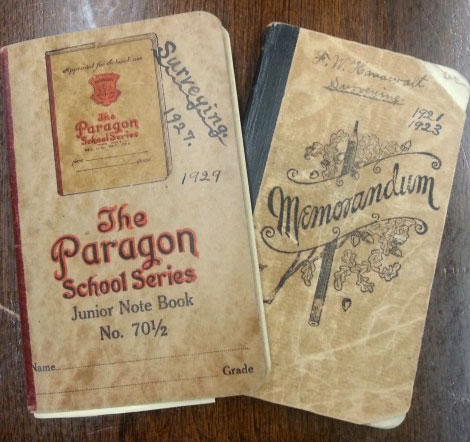Mss.027, Bills of Sale for the Purchase of Slaves:
This collection includes three original handwritten receipts for the purchase of Slaves dated July 4, 1835, June 21, 1837, and September 19, 1845.
Mss.028, T.H. Callaway letter to James R. Callaway:
This four-page letter from a confederate soldier in Holly Springs, Mississippi to his uncle recounts his participation in the Second Battle of Corinth, October 3-4, 1862. He discusses the lack of food, clothing and provisions for himself and his fellow soldiers, and the horrors of war.
Mss.029, Francis Wayland Hanawalt Teaching Notebooks:
This collection consists of teaching notebooks related to surveying.
Mss.030, Civil Marriage Agreements:
This collection contains four original, mostly handwritten documents from Mexico pertaining to civil marriage arrangements written in Spanish and Castilian. Two agreements are dated 1773, and the remaining two are dated 1778.
This collection of imprints of the National Association for the Advancement of Colored People document the organization’s first half-century.
Mss.045, C. Brewster Coulter papers:
Coulter was a history professor at Puget Sound from 1945-1980. This collection includes an onion skin copy of his book manuscript “The Big Y Country,” as well as photographs, negatives, and fruit crate labels.
Mss.050, Grafton Tyler Brown Lithographed Receipt:
This collection contains a printed and handwritten business receipt, lithographed by G.T. Brown & Co., San Francisco for J.&P.N. Hanna, Cotton Importers, 308-310 Davis Street, San Francisco. Grafton Tyler Brown was born in Pennsylvania before the Civil War to freed slaves. In his early 20s, he moved to San Francisco, working as a lithographic artist for a printing company before opening his own business in 1867, designing and printing stock certificates, maps and other documents for companies like Wells Fargo Mining, Levi, Strauss, and Ghirardelli Chocolate. In the 1870s, Brown sold his printing business to become a full-time artist, painting landscapes at his studios in British Columbia, Portland, and Tacoma, and finally settled as an Army Engineer in Minnesota, where he died in 1918.
Mss.051, Tacoma Community House: A Social Settlement:
This sociology 101 paper written was by Georgina Rowland in 1932, on the history of the Tacoma Community House, a missionary effort of the Methodist Church that began in 1907. The Tacoma Community house began with the goal of providing a safe, educational space for children and had many innovative programs for their time, including a baby clinic, the first kindergarten classes in Tacoma, and English classes for recent immigrants.
Mss.056, Murray Johnson collection on the Cape Thompson Environmental Impact Report:
Dr. Murray L. Johnson, M.D., was a Professor of Biology at the University of Puget Sound and helped establish the mammalian collections at the Puget Sound Museum (now the Slater Museum of Natural History) in 1948. He was contracted by the Atomic Energy Commission (AEC) to conduct a study of marine mammal ecology in the region around Cape Thompson, Alaska, between 1960 and 1961. The Murray Johnson Collection on the Cape Thompson Environmental Impact Reports consists of correspondence, biological data, and publications from Dr. Murray L. Johnson’s work as a marine mammal researcher.
Mss.047, Literary Managers and Dramaturgs of the Americas Records:
LMDA is a multinational organization devoted to serving professional dramaturgs and supporting, affirming and broadening the practice of dramaturgy in the performing arts. The records of the LMDA span the years 1983-2015 and document the development of this organization from its creative inception by leaders C. Lee Jenner and Alexis Greene to its incorporation into a formal non-profit organization to legal engagements of the late 1990s to its administrative present.
Mss.009, Walter S. Davis papers:
Davis was a Washington State Senator (1912-1928) and a professor of history and political science at the College of Puget Sound (now University of Puget Sound), in Tacoma, Washington, from 1907-1943. The collection contains mainly CPS-related correspondence, papers, notebooks, lecture notes, and also genealogical information.
Mss.017, Oregon Methodist Missions papers:
These letters describe the daily life, hardships, and deaths associated with the work of missionaries and their families. Some passages deal with the death of a child and the separation of husband from wife. One description is of the Native American encampment on the banks of the Columbia River in the autumn during the salmon run when it almost seemed one could cross the river by walking on the fish migrating upstream. Includes the journal of H. K. W. Perkins (Aug. 12, 1843, to March 19, 1844; 106 pages) in which he describes his work and travels as a missionary in Oregon.
Mss.040, Howard W. Robbins diary:
Robbins was a first lieutenant in the 104th Infantry Regiment of the U.S. army. The diary is a manuscript notebook from World War I (1917-1918), which includes 88 pages of handwritten material. The text is illustrated with graphs, formulas, and diagrams.
Want to take a look at some of these newly available resources? Stop by the A&SC during open hours during the semester on Tuesdays, Wednesdays, and Thursdays from 1:00-3:00 p.m. or email the Katie Henningsen to make an appointment.
Stay tuned to this page for the latest updates on newly available collections!
By Kara Flynn ‘15

